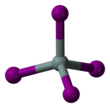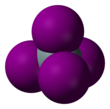Silicon tetraiodide
|
| |||
| Names | |||
|---|---|---|---|
| Other names
silicon tetraiodide
Tetraiodosilane | |||
| Identifiers | |||
3D model (JSmol)
|
|||
| ChemSpider | |||
| ECHA InfoCard | 100.033.355 | ||
PubChem CID
|
|||
CompTox Dashboard (EPA)
|
|||
| |||
| |||
| Properties | |||
| SiI4 | |||
| Molar mass | 535.7034 g/mol | ||
| Appearance | white powder | ||
| Density | 4.198 g/cm3 | ||
| Melting point | 120.5 °C (248.9 °F; 393.6 K) | ||
| Boiling point | 287.4 °C (549.3 °F; 560.5 K) | ||
| insoluble | |||
| Solubility in organic solvents | soluble | ||
| Structure | |||
| tetrahedral | |||
| Hazards | |||
| NFPA 704 (fire diamond) | |||
| Flash point | −18 °C (0 °F; 255 K) | ||
Except where otherwise noted, data are given for materials in their standard state (at 25 °C [77 °F], 100 kPa).
| |||
Silicon tetraiodide is the chemical compound with the formula SiI4. It is a tetrahedral molecule with Si-I bond lengths of 2.432(5) Å.[1]
SiI4 is a precursor to silicon amides of the formula Si(NR2)4 (R = alkyl).[2] It has also been of interest in the manufacture and etching of silicon in microelectronics.
Reactions
The compound is stable to strong heating and can be stored for long periods at room temperature but must be kept dry as it reacts quickly with water and also reacts slowly with moisture in the air in a similar way to silicon tetrachloride. It can be made on a large scale by reaction of silicon or silicon carbide with iodine on heating to about 200 °C. Of more academic interest is the reaction of silane with iodine vapour at 130 - 150 °C, as this produces a series of compounds ranging from iodosilane SiH3I to diiodosilane SiH2I2 and triiodosilane SiHI3 as well. These compounds are colourless liquids at room temperature. [3]The last one can be readily distinguished from the similar carbon compound, iodoform which is a yellow solid at room temperature.
References
- ^ Kolonits, Maria; Hargittai, Magdolna (1998). Structural Chemistry. 9 (5): 349. doi:10.1023/A:1022462926682.
{{cite journal}}: Missing or empty|title=(help) - ^ Banerjee, Chiranjib; Wade, Casey R.; Soulet, Axel; Jursich, Gregory; McAndrew, James; Belot, John A. (2006). "Direct syntheses and complete characterization of halide-free tetrakis(dialkylamino)silanes". Inorganic Chemistry Communications. 9 (7): 761. doi:10.1016/j.inoche.2006.04.027.
- ^ Greenwood, Norman N.; Earnshaw, Alan (1997). Chemistry of the Elements (2nd ed.). Butterworth-Heinemann. ISBN 978-0-08-037941-8.



